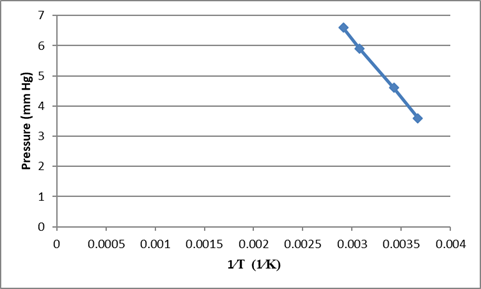
(a)
Interpretation:
The normal boiling point of dichlorodimethylsilane has to be determined
Concept Introduction:
Boiling point of a liquid: The temperature at which external pressure and vapour pressure of the liquid become same.
Normal boiling point: When the external pressure is
(a)
Answer to Problem 39IL
The normal boiling point of dichlorodimethylsilane is
The temperatures at which liquid have a vapour pressures of
The molar enthalpy of vaporization of is
Explanation of Solution
The normal boiling point of dichlorodimethylsilane is calculated
Given:
Normal boiling point is the temperature when the external pressure is
From the given data it is clear that the temperature at which the pressure is
Thus the normal boiling point of dichlorodimethylsilane is
(b)
Interpretation:
The graph of
Concept Introduction:
Clausius-Clapeyron equation:
From this relationship we can calculate the molar enthalpy of vaporization by knowing the corresponding temperature and pressure values.
If we have pressures at two different temperatures, then enthalpy of vaporization can be calculated by
(b)
Answer to Problem 39IL
Using the given data we can plot the graph of

The temperature at which liquid has a vapour pressure of
The temperature at which liquid has a vapour pressure
Explanation of Solution
The temperatures at which liquid have a vapour pressures of
Given:
The values of
Using the given data we can plot the graph of

From the slope of the graph we can find the value of
Using the equation for the straight line in the plot
C, the constant value can be calculated by substituting any one of the value of pressure and temperature from the table given in the equation.
Substituting the values
From this equation we can calculate the temperature at which the pressures are
When the pressure is
The temperature at which the pressures is
When the pressure is
The temperature at which the pressures is
(c)
Interpretation:
The molar enthalpy of vaporization has to be explained.
Concept Introduction:
Clausius-Clapeyron equation:
From this relationship we can calculate the molar enthalpy of vaporization by knowing the corresponding temperature and pressure values.
If we have pressures at two different temperatures, then enthalpy of vaporization can be calculated by
Boiling point of a liquid: The temperature at which external pressure and vapour pressure of the liquid become same.
Normal boiling point: When the external pressure is
Molar enthalpy of vaporization: The energy required to convert liquid to gas of 1mol of a substance is called molar enthalpy of vaporization
(c)
Answer to Problem 39IL
The molar enthalpy of vaporization of is
Explanation of Solution
Given:
The molar enthalpy of vaporization using the given data is calculated.
Substituting the values
The molar enthalpy of vaporization using the given data is
Want to see more full solutions like this?
Chapter 11 Solutions
CHEMISTRY+CHEM...HYBRID ED.(LL)>CUSTOM<
- Calculate the pH and the pOH of each of the following solutions at 25 °C for which the substances ionize completely: (a) 0.000259 M HClO4arrow_forwardWhat is the pH of a 1.0 L buffer made with 0.300 mol of HF (Ka = 6.8 × 10⁻⁴) and 0.200 mol of NaF to which 0.160 mol of NaOH were added?arrow_forwardDetermine if the following salt is neutral, acidic or basic. If acidic or basic, write the appropriate equilibrium equation for the acid or base that exists when the salt is dissolved in aqueous solution. If neutral, simply write only NR. Be sure to include the proper phases for all species within the reaction. NaN₃arrow_forward
- A. Draw the structure of each of the following alcohols. Then draw and name the product you would expect to produce by the oxidation of each. a. 4-Methyl-2-heptanol b. 3,4-Dimethyl-1-pentanol c. 4-Ethyl-2-heptanol d. 5,7-Dichloro-3-heptanolarrow_forwardWhat is the pH of a 1.0 L buffer made with 0.300 mol of HF (Ka = 6.8 × 10⁻⁴) and 0.200 mol of NaF to which 0.160 mol of NaOH were added?arrow_forwardCan I please get help with this.arrow_forward
- Determine if the following salt is neutral, acidic or basic. If acidic or basic, write the appropriate equilibrium equation for the acid or base that exists when the salt is dissolved in aqueous solution. If neutral, simply write only NR. Be sure to include the proper phases for all species within the reaction. N₂H₅ClO₄arrow_forwardPlease help me with identifying these.arrow_forwardCan I please get help with this?arrow_forward
 Chemistry: The Molecular ScienceChemistryISBN:9781285199047Author:John W. Moore, Conrad L. StanitskiPublisher:Cengage Learning
Chemistry: The Molecular ScienceChemistryISBN:9781285199047Author:John W. Moore, Conrad L. StanitskiPublisher:Cengage Learning
